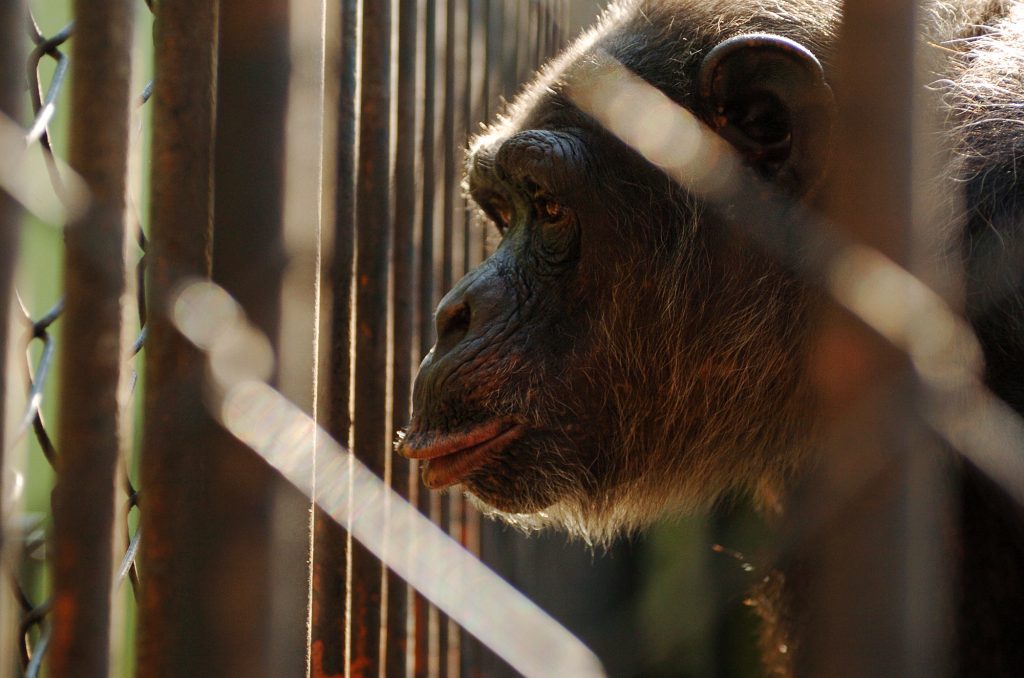Should Chimps Be Considered People Under the Law?

In late 2013, the Nonhuman Rights Project (NhRP) filed a first-ever lawsuit to free a pet chimpanzee named Tommy from the inadequate conditions provided by his owner. The NhRP, a legal group focused on animal protection, argued that Tommy is an autonomous being who is held against his will and that he is entitled to a common-law writ of habeas corpus, a legal means of determining the legality of imprisonment. Granting habeas corpus to a chimpanzee would mean viewing chimpanzees as legal persons with rights, rather than as mere things, so this case was rather controversial.
The Tommy case came to a close on December 4, 2014, as the Appellate Division of the New York State Supreme Court’s five-judge panel ruled against the NhRP. (The state’s highest court is the Court of Appeals.) Justice Karen K. Peters, the presiding judge, wrote: “Needless to say, unlike human beings, chimpanzees cannot bear any legal duties, submit to societal responsibilities or be held legally accountable for their actions. In our view, it is this incapability to bear any legal responsibilities and societal duties that renders it inappropriate to confer upon chimpanzees the legal rights … that have been afforded to human beings.”
Close to a year later, the NhRP filed a new lawsuit on behalf of Tommy. This time, the group had 60 additional pages of affidavits from professors of primate behavior describing the impressive cognitive and emotional capacities of chimpanzees. The NhRP’s hope was that this evidence would be sufficient to reverse the decision. It wasn’t: The court declined to hear the case.
That’s not to say the NhRP isn’t right about the capacities of chimpanzees. As the affidavits attested, scientific evidence overwhelmingly demonstrates that chimps and other select species—bonobos, gorillas, orangutans, dolphins, orcas, and elephants—are not only conscious, but also possess a sense of self, and, to some degree, a theory of mind. They have intricate, fluid social relationships, which are influenced by strategy and the ability to plan ahead, as well as a sense of fairness and an empathetic drive to console and help one another. In many ways (though certainly not all), they’re like young children. The NhRP contends, based on this, that chimpanzees are capable of bearing some duties and responsibilities.
But is that line of argument really necessary? Young children can’t bear duties and responsibilities, yet they are still considered legal persons with rights. Child abuse is viewed as a violation of those rights. (In contrast, animal abuse is a victimless crime in legal terms, like gambling or drug use.) So how do we justify granting legal rights to children, despite their incapability to bear duties and responsibilities? Perhaps it’s because children will eventually grow older, at which point they will bear duties and responsibilities. But then what about terminally ill children who, tragically, will never grow up? What about elderly people with dementia, who, because of their condition, are unable to fulfill legal and societal responsibilities and duties?
Perhaps before the law is willing to view apes, cetaceans, and elephants as nonhuman persons, we as a society need to start viewing them as nonhuman people.
We all agree that these groups deserve legal personhood and the according rights and protections. So why not Tommy? It seems we deny personhood to chimpanzees and the other species listed above not because they can’t bear duties or responsibilities, nor because they lack any mental capacities that all humans possess, but simply because they aren’t human. This is a double standard.
It is this double standard, not sound logical reasoning, that determined the judges’ ruling on the Tommy case. It appears as if they didn’t even entertain the possibility that some nonhuman species could rightly be viewed as persons under the law; instead the ruling was subconsciously decided, based on the faulty conflation of “person” with “human,” before the case even took place. The “duties and responsibilities” argument was not the true basis for the decision but a form of retrospective rationalization. And I think the same response will be given as the NhRP brings more cases to court.
So what has to happen in order for Tommy to be granted legal personhood and protected accordingly? The legal system generally follows society’s views. Perhaps before the law is willing to view apes, cetaceans, and elephants as nonhuman persons, we as a society need to start viewing them as nonhuman people.
Consider that these select species are intelligent and emotional enough that their subjective experience of abuse—their suffering—is likely similar to that of a human child. When we see them locked in tiny crates as pets, or taken from their mothers as infants to be trained to entertain, we need to react like they are children. The double standard needs to be erased in the minds of the public to the point where nonhuman personhood is commonsensical. Then, and I believe only then, will the legal system follow suit.



























